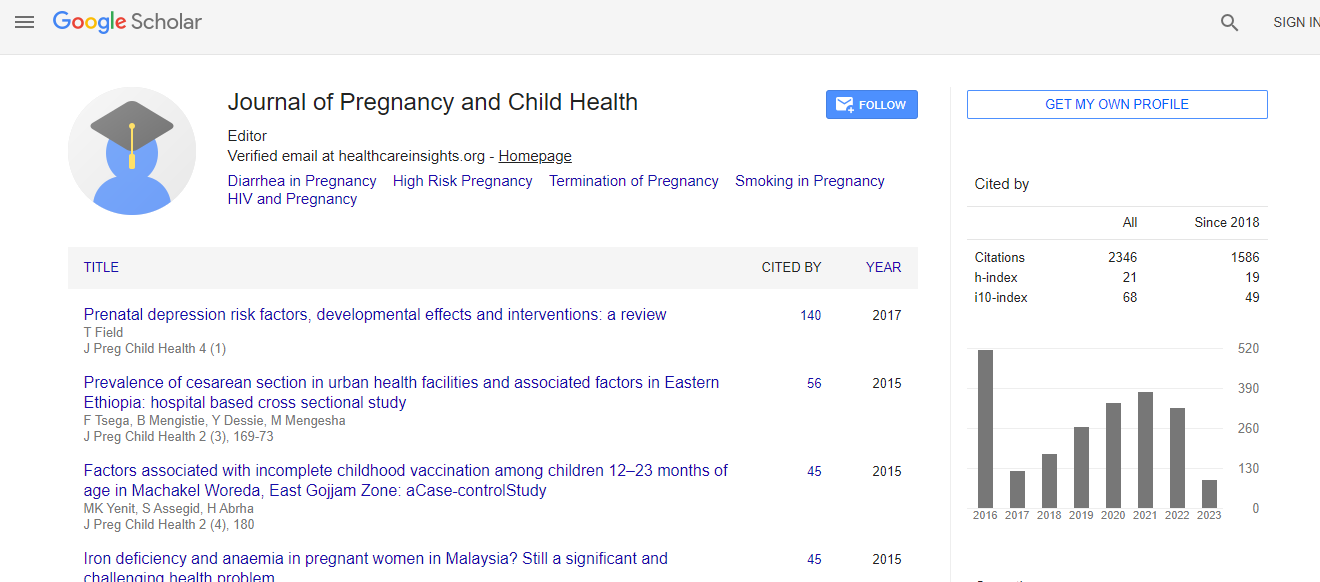Research Article
Assessing the Effectiveness of S ã o Paulo ’ s Policy Efforts in Lowering Teenage Pregnancies and Associated Adverse Birth Outcomes
| Alexandra Brentani1*, Gunther Fink2, Maria Lucia Bourroul3 and Sandra JFE Grisi1 | |
| 1Faculdade de Medicinada Universidade de São Paulo, Brazil | |
| 2Harvard School of Public health - Department of Global Health and Population, Brazil | |
| 3Secretaria Municipal de Saúde, Prefeitura de São Paulo, CEINFO, Brazil | |
| Corresponding Author : | Alexandra Brentani Faculdade de Medicinada Universidade de São Paulo, Brazil Tel: 55 11 983319050 E-mail: brentani.alexandra@gmail.com |
| Received December 15, 2014; Accepted April 16, 2015; Published April 18, 2015 | |
| Citation: Brentani A, Fink G, Bourroul ML, Grisi SJFE (2015) Assessing the Effectiveness of São Paulo’s Policy Efforts in Lowering Teenage Pregnancies and Associated Adverse Birth Outcomes. J Preg Child Health 2:151. doi: 10.4172/2376-127X.1000151 | |
| Copyright: © 2015 Brentani A, et al. This is an open-access article distributed under the terms of the Creative Commons Attribution License, which permits unrestricted use, distribution, and reproduction in any medium, provided the original author and source are credited. | |
Abstract
Objective: To assess the impact ofBrazil’spolicyefforts introduced in 2008 to reduceadolescent fertility rates as well as improve adolescent birth outcomes in the São Paulo metropolitan area of Brazil. Methods: Pregnancy records for teenage mothers for the entire municipality were retrieved from theMunicipality Health Secretariat’s Information System for the period 2004 to 2011. Records extracted included information on the number of prenatal consultations, delivery modality, gestational length, and birth weight and survival status for teenage mothers. Two-sample mean difference tests were computed to compare the pre-period 2004-2007 tothe post- period 2008-2011 both for the aggregate São Paulo municipality, and each of the five regions in the municipality. Results: Adolescent fertility rates declined from 52.2 to 50.8 births per 1000 females of age 15-19 in the municipality from the (pre) period 2004-2007to the (post) period 2008-2011 (β=-1.5, p-value <0.001). The largest decrease in adolescent fertility was observed in the center-western region (β= -3.2, p-value <0.001), while the southern region experienced a small but statistically insignificant increase in adolescent fertility (β=0.2, p-value=0.669).Over the same period, access to prenatal care among adolescent mothers improved, with the fraction of teenage mothers reporting less than seven antenatal care visits declining from 41.4% in the pre- to 37% in the post period (p-value < 0.001). While the risk of low birth weight declined marginally (β=-0.003, p-value=0.041), no differences were observed with respect to preterm birth and modality of delivery. Surprisingly large increases were found in the likelihood of teenage pregnancies resulting in stillbirth, from 1.8 stillbirths per 1000 deliveries in the pre-period to 4.3 deaths per 1000 teenage deliveries after the introduction of the policy efforts. Discussion and Conclusion: The findings presented suggest that teenage fertility rates have declined marginallybetween the pre-and post-reform periods. Given the relatively large increase in the number of stillbirths over the same period, the overall program impact on teenage pregnancies is likely limited. While the observed increases in stillbirthsmay at least partially reflect changes in the reporting of stillbirth, further research will be needed to better understand these unexpected trends. More generally, further efforts and new strategies to prevent teenage pregnancies will need to be considered if the government objectives of achieving large reductions in teenage fertility are to be achieved.

 Spanish
Spanish  Chinese
Chinese  Russian
Russian  German
German  French
French  Japanese
Japanese  Portuguese
Portuguese  Hindi
Hindi 
